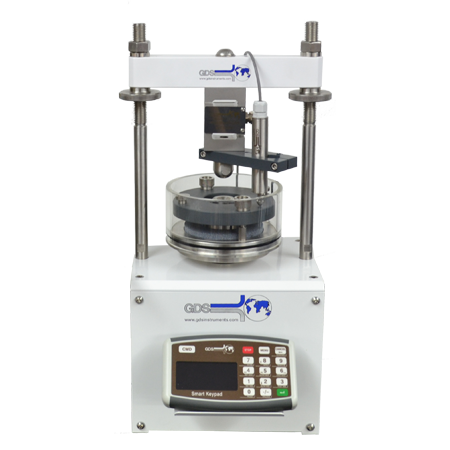Features and Benefits:
Product Code : GDSAOS
The GDSAOS is a self-contained stepper motor driven unit that can be controlled either manually using its Smart Keypad or from a PC using the USB interface. There is no requirement for compressed air or manually placed weights. When used with the GDSLAB control and data acquisition software, the GDSAOS can be used for a complete array of tests beyond those which a hanging weight oedometer can perform.
| Key features | Benefits to the user |
|---|---|
| Automatic transition between test increments for all soil types, with no need of user estimated parameters input during test set-up: |
Results from tests on over consolidated clay, produced a reduction in test duration of 42%. |
| Direct replacement for a hanging weight oedometer system: | The GDSAOS is a stand-alone unit (with no requirement for compressed air). Having a small footprint significantly reduces the bench space required coupled with the additional advantage that loading weights are not required. |
| Automated logging of data (and optionally reporting): | Automation saves time recording results and controlling the test. |
| Incremental loading stages: | When using GDSLAB the GDSAOS can be preprogrammed to include numerous incremental loading stages which automatically move to the next stage via preprogrammed end of consolidation conditions, thus increasing sample throughput. |
| Accurate results throughout the load range: | From 1N to 10kN the GDSAOS electro-mechanical pressure controlled systems provide accurate results, compared to pneumatic consolidation systems that are typically inaccurate at low loads. |
| Utilise existing equipment: | If upgrading from a PC logged hanging weight system, it may be possible to utilise the current consolidation cells, transducers and data loggers. Many data loggers, even those from other manufacturers, are compatible with the GDSLAB software. |
Technical Specification:
| Axial Force Accuracy |
0.1%FRO, |
|---|---|
| Dimensions |
W/D/H - 220mm, 260mm (including keypad), 656mm |
| Displacement Accuracy |
0.2% (Can be improved to 0.1% with an external transducer connected to an RFM) |
| Displacement Range |
Nominal 40mm |
| Displacement Resolution |
0.0001mm (0.1µm) |
| Load Range (kN) |
Max Load 10kN |
| Power |
110 to 240 AC Volt Input, 60Watts, 50/60Hz |
| Sample Sizes |
Standard Cell Size: 50, 63.5, 70, 75 & 100mm Custom Cell Size: 25, 38, 71.4, 101.6 & 112.8mm |
Upgrade Options:
- GDSLAB with the Oedometer module – Automated testing (step loading) and data acquisition.
- External Displacement transducer – Increases the accuracy of strain measurements (generally required to comply with national standards). The recommended transducer is a USB digital dial gauge for simplicity, ease of use, and the reassurance of a reading on the transducer.
- With the addition of an RFM the device can measure and control from an additional transducer, i.e. axial displacement or pore pressure.
- Note 1: If upgrading from a PC logged hanging weight system, it may be possible to utilise the current data logger and transducers as many data loggers, even those from other manufacturers, are compatible with the GDSLAB software.
- Note 2, Multiple cell systems: The GDSAOS can be arranged in greater numbers connected to a single PC or to multiple PCs. Commonly oedometers are used in groups of 4-6 and these can all be connected to GDSLAB and controlled with tests starting at different times and differing load increments.
- Bender Elements System

 Enquiry:hkmarketing@epc.com.hk
Enquiry:hkmarketing@epc.com.hk 











